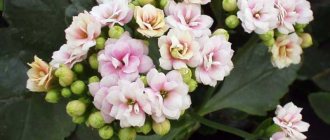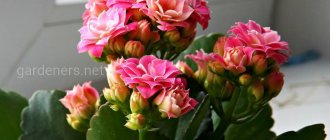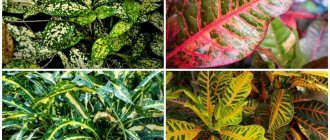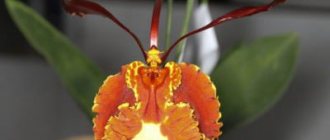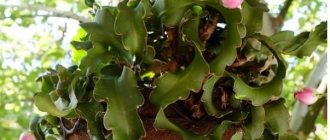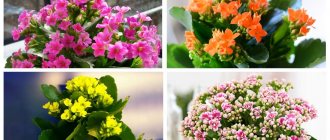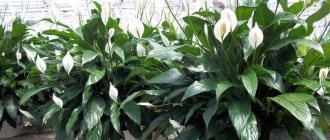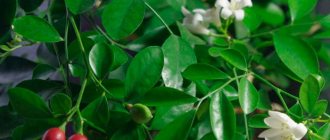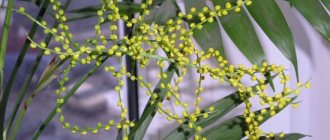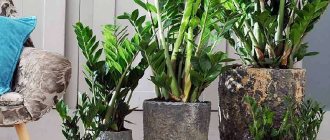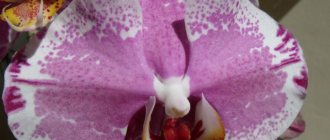Kalanchoe daigremontiana is a succulent belonging to the Crassula family. The birthplace of the flower is Madagascar. The succulent is popularly called viviparous. Since 1925, gardeners have been growing the plant as a houseplant. The main feature of Kalanchoe Degremon is that it is healing and can cure numerous ailments.
The plant is noticeably different from other species and varieties of Kalanchoe. Looking at the photo of Kalanchoe Degremon, you can see that the perennial succulent reaches 100 cm in height and has fleshy, elongated leaves. The leaves are green and dusty green in color, smooth to the touch with jagged edges.
Briefly about care
- Watering. In hot weather, Madagascar crops should be watered only after the top layer of soil has completely dried. In winter, the bush is watered approximately once a month.
- Illumination. The plant needs a significant amount of sunlight, however, on especially hot days, you need to shade the flower, otherwise it will dry out. During the cold season, the succulent should be kept on the south side of the windows, as the plant will not have enough natural light.
- Air humidity. This exotic plant loves dry air. Spraying the bush will be unnecessary.
- Temperature conditions. The air temperature should not be higher than 27 °C and lower than 12 °C.
- Bloom. A healthy plant blooms in winter with bell-shaped inflorescences of red or pink color.
- Trimming. After the crop has faded, it is necessary to remove the flower stalks.
- Transfer. A young plant must be replanted once a year. Adult specimens - as needed.
- Priming. The soil mixture should consist of sand and turf, leaf soil.
- Fertilizers. Fertilizers for succulents are used as top dressing.
- Reproduction. By cuttings and seeds.
- Diseases. Mold, rot, sunburn and powdery mildew.
- Parasites. Mealybugs, aphids and scale insects.
Kalanchoe Degremona is an undemanding plant that can be easily grown at home or in the country. Like all plants, Kalanchoe Degremona requires basic care at home. A healthy flower can please your household with beautiful blooms.
The plant and its medicinal properties
The healing properties are determined by the rich content of biologically active substances in the leaves and shoots of Kalanchoe Degremona:
- vitamins A, C;
- flavonoids;
- tannins;
- polysaccharides;
- enzymes and organic acids;
- bactericidal complexes;
- microelements – magnesium, copper, aluminum, zinc, calcium;
- mineral salts.
Due to their unique natural composition, preparations based on plant juice are used to treat:
- influenza, ARVI;
- infections of the throat and nose - sore throat, tonsillitis, sinusitis, sinusitis, otitis media;
- skin lesions and wounds - psoriasis, eczema, furunculosis, bedsores, trophic ulcers, burns;
- eye injuries, conjunctivitis;
- herpes;
- tuberculosis;
- cervical erosion, postpartum injuries;
- periodontal disease, stomatitis.
The list of these diseases suggests that Kalanchoe has antiviral, bactericidal, anti-inflammatory, regenerating, and tonic properties.
Use in folk medicine
The medicinal properties of the plant became known in the second half of the 20th century. Now Kalanchoe is actively used in folk medicine. At home, juice, ointments, and alcohol infusions are prepared from it, which help fight diseases.
Juice
Kalanchoe juice:
- has high biological activity;
- has an anti-inflammatory effect;
- promotes rapid healing of wounds and ulcers of various etiologies.
7 days before harvesting the leaves, stop watering the plant.
For preparation:
- Leaves and leafy shoots are cut off from the lower part of the plant - they are more mature.
- After trimming, the leaves must be placed in the refrigerator for 5 to 7 days. During this time, the content of biologically active substances in them increases sharply, as the plant, as it were, tries to “heal” the cut areas.
- After the expiration date, the leaves are crushed and the juice is squeezed out, which is stored in the refrigerator or in a dark, cool place at a temperature of 4-10 degrees. Shelf life 7 days.
- The juice is used externally in the form of dressings in the treatment of ulcers, purulent abscesses, bedsores, and non-healing wounds. For the first 3 days, the dressings are changed daily, then once every three days.
- For eczema, psoriasis, acne, apply 6-7 drops of juice to the affected area for 6-8 days.
- For a runny nose or ARVI, drop 2 drops into the nose 2-3 times a day until symptoms disappear.
- For sore throat, tonsillitis, stomatitis, gargle and rinse the mouth, diluting the juice with water in a 1:1 ratio.
- When treating tuberculosis in complex therapy, the juice is taken orally, preparing a solution - 1 tsp. juice + 3 tsp. water. Drink 2 times a day after meals. Don't forget to consult your doctor.
- For conjunctivitis, juice diluted with water 1:1 is applied as a compress to the eyes 3 – 5 times a day.
- To increase immunity and after illness, it is useful to eat 1 teaspoon of “babies” every morning on an empty stomach, which are formed along the edges of the leaves. Course 30 days.
Before using Kalanchoe, consult your doctor, the doctor will determine the dose and duration of the course.
Alcohol tincture
Unlike juice, tincture prepared with alcohol can be stored for 12 months. It is used to treat the above diseases, provided it is diluted with water 1:3:
- gargling for sore throat, tonsillitis;
- lotions, compresses, rubbing;
- nasal drops for inflammation of the nasopharynx;
- with success, as rubbing is used for varicose veins, and for removing spider veins on the skin;
- used internally for stomach diseases - 1 teaspoon in the morning on an empty stomach for a month.
Vodka recipe:
- Fill a glass bottle or jar to the top with chopped leaves, add vodka, and place in a dark place for 7 days.
- Filter and store in a dark place at a temperature not exceeding 10 degrees. within 12 months.
Alcohol recipe:
- Prepare juice from the leaves.
- Keep the juice in the refrigerator for 2 days.
- Carefully pour the juice into a glass container without disturbing the sediment.
- Dilute the juice with alcohol 20:1
To prepare tinctures, use only glass containers, as contact of alcohol with plastic can release toxins.
Ointment
Ointment prepared from Kalanchoe Degremona is successfully used to treat:
- varicose veins;
- trophic ulcers;
- bites;
- difficult-to-heal wounds.
Recipe:
- 30 ml Kalanchoe juice;
- 50 g base (vaseline, lanolin, butter);
- Mix the ingredients thoroughly and put in the refrigerator.
Ointment:
- strengthens the walls of blood vessels;
- accelerates epithelization in case of skin damage;
- easy to prepare.
Use for cosmetic purposes
The use of Kalanchoe in home cosmetology is due to the fact that the substances in the plant:
- lighten the skin;
- strengthen the walls of blood vessels;
- exfoliate old cells;
- remove inflammation;
- stimulates lymphatic drainage and improves blood circulation.
As a result, facial skin looks more youthful and radiant.
For puffiness and bags under the eyes
Soak cotton pads in the juice and apply to your eyes for 20 minutes, taking a horizontal position. The effect will be visible after the first use.
For warts
Prepare a paste of leaves, apply to the problem area, cover with a bandage or bandage. Do this at night.
For acne
Let's prepare the acne lotion:
- Cut 2 large Kalanchoe leaves and pour 200 ml of boiling water;
- After 2 hours, strain and squeeze.
Wipe your face with lotion morning and evening. You can treat problem areas with fresh leaves, after removing the protective layer.
For hair growth
To stimulate hair growth, you can use alcohol tincture . Rub it into the roots of your hair before washing your hair. The procedure warms up and irritates the hair follicles, due to the increasing flow of blood to the scalp.
For facial care
Kalanchoe Degremona juice is ideal for caring for mature and problem skin. Based on it, you can prepare various masks at home. To do this you need:
- Mix 1 tablespoon of juice and 1 tablespoon of honey or cream or add egg yolk.
- Apply the mask to previously cleansed skin for 20 minutes.
You can prepare a cream by mixing juice with glycerin or lanolin in a 1:1 ratio.
Contraindications for use
Like many medicinal plants, Kalanchoe Degremona has contraindications:
- allergic reactions;
- hepatitis, liver cirrhosis;
- hypotension;
- oncological diseases;
- joint diseases;
- during pregnancy and breastfeeding.
Self-medication is harmful! Consult your doctor before self-medicating.
Illumination
The southern plant loves sunlight. The flower can be kept on the windowsill on the east or south-east side. On especially hot days, Kalanchoe needs to be shaded and protected from the burning rays of the sun.
The sun's rays can cause the flower to burn - the leaves will turn yellow, begin to dry out and fall off.
In the winter season, the flower can be safely kept on the windows on the south side, and, if necessary, illuminated with special lamps.
Kalanchoe Degremona in a pot
Folk names
Kalanchoe Degremona is popular among gardeners. In addition to its medicinal properties, the plant is easy to grow and care for. In home medicine, Kalanchoe-based products are very popular because they are always at hand and are very effective.
In addition to its name, Kalanchoe Degremona is popularly called:
- the tree of Life;
- Goethe's flower;
- home doctor;
- homemade ginseng;
- plant - doctor.
These “nicknames” speak for themselves.
The great Goethe was delighted with this plant and mentioned it in his letters. There is a legend that it was Goethe who introduced Degremon’s Kalanchoe into culture, having received a leaf as a gift from a friend.
Bloom
Many plant growers are tormented by the question: when and how does Kalanchoe Degremona bloom? Kalanchoe Degremona usually blooms in the winter season. Therefore, pink cone-shaped flowers can be expected for the New Year or Christmas. And if your flower has bloomed, you will admire it from several weeks to several months.
Flowering Kalanchoe Degremona
Kalanchoe Degremona flowers
Common Pests
Kalanchoe pests rarely attack, but this possibility cannot be ruled out. The information from the table will help you recognize pests in a timely manner and begin to combat them.
Table - Main pests of Kalanchoe Degremona
| Insect | Signs | Ways to fight |
| Aphid | — Sticky coating; - curling of young shoots and leaves; - colonies of small green insects | — Washing with soapy water; - spraying with infusion of tobacco dust; - spraying with insecticides |
| Shchitovka | — Brown, reddish plaques on stems and leaves; - sticky drops on the stems; - wilting of the plant | — Mechanical removal of insects; - washing with soapy water; - repeated treatment with fungicides |
| Root mealybug | — Kalanchoe wilting for no apparent reason | — Transplantation; — treatment of the root system with fungicides; - replacing soil and pot; - reducing the frequency of watering |
| Spider mite | — Small yellow dots on the leaves; - a thin cobweb on the back of the sheet; - yellowing of leaves | — Increased air humidity; - treatment with insecticides |
The most effective insecticides are “Fitoverm”, “Akarin”, “Aktellik”, “Inta-vir”. In case of minor damage, a single treatment is sufficient; in case of mass distribution of insects, it is necessary to treat up to three times.
Caring for Kalanchoe Degremona takes a minimum of time. The plant combines high decorative qualities and healing properties. This explains the wide distribution of Kalanchoe as a houseplant.
Reproduction
Kalanchoe reproduces in several ways: by cuttings and seeds.
By cuttings
You can propagate shrubs using cuttings at any time of the year, but it is not recommended to do this during the flowering period or immediately after.
To make cuttings, you need to break off a branch of a bush and place it in a bottle with water. After the roots appear, you can plant the cuttings in the ground. The young plant is watered generously with water at room temperature.
Reproduction of Kalanchoe Degremona
Seeds
The seed propagation method is long and problematic. Seeds can be purchased at a flower shop or collected from the plant.
It is recommended to sow seeds in February or March.
The seeds need to be immersed in a soil mixture consisting of turf soil and sand. The soil must be moist. When planting, you do not need to bury the seeds in the ground, they should be on the surface. After planting, the container with soil must be covered with glass. The top of the glass must be covered with thick paper that will not transmit light. The seedlings should be ventilated daily.
Types of Kalanchoe
- Kalanchoe Blossfeldiana Kalanchoe blossfeldiana - native to Madagascar, is a low-branched, erect shrub, about 30 cm tall with opposite round or oblong leaves, wavy along the edge, about 5-7 cm long. The flowers are small - about 1 cm in diameter, bright red, look impressive in inflorescences - umbrellas. Flowering from March to June, very abundant. There are varieties with orange, yellow and other flowers.
Kalanchoe Blossfeld
Kalanchoe Blossfeld
Kalanchoe Blossfeld
- Kalanchoe Kalandiva Kalanchoe blossfeldiana 'Calandiva' is a very popular variety of double Kalanchoe Blossfeld, its flowers are multi-petaled, like miniature roses. The colors of Kalandiva flowers are very different - white, yellow, pink, red. The plants are compact and bloom abundantly.
Kalanchoe Kalandiva
Kalanchoe Kalandiva
Kalanchoe Kalandiva
- Kalanchoe Mangina Kalanchoe manginii - has small leaves up to 3 cm long, obovate in shape, with a serrated edge, sessile opposite on short petioles. The corolla of the flower is orange-red, fused into a long tube, about 2-2.5 cm long. The flowers are drooping, on long stalks.
- Kalanchoe Degremona Kalanchoe daigremontiana - originally from Madagascar, about 50-70 cm high. A plant with narrow-ovate fleshy leaves (the shape of an elongated triangle), up to 15-20 centimeters long, grayish-green in color, with purple spots on the reverse side. Numerous babies are formed in the depressions along the jagged edge, which easily fly around and take root. The inflorescence is a panicle, the flowers are about 1.5 cm in diameter, pink, blooms in winter.
- Kalanchoe dissected (lobed) Kalanchoe laciniata - originally from Africa and Asia, a perennial herbaceous plant with erect (in older plants lodging) shoots. The leaves are deeply dissected, with a serrated edge, fleshy, green, shiny. Flowers in few-flowered umbellate inflorescences. The corolla is tubular, short, yellow. It is popularly called “Deer Horns”.
- Kalanchoe pinnata is a plant with an erect stem; at home it grows up to 80 cm in height. Leaves are opposite, on small petioles, young leaves are almost sessile. The leaves are on average up to 10 cm long, dense, oval in outline with a serrated edge. Very often, “brood” buds form between the cloves, from which tiny babies grow. The inflorescence is a panicle. The flowers have sepals fused into a wide tube up to 3 cm long. The ends of four petals, also fused at the base and bent at the ends, protrude slightly from it. The flowers themselves are not bright. The tube is green, the ends of the petals are pink. The fruit is a capsule with small seeds.
Kalanchoe Mangina
Kalanchoe pinnate
Kalanchoe Boveri
- Kalanchoe Beauverdii Kalanchoe beauverdii - this plant is distinguished by narrow long leaves up to 5 cm long and 3-5 mm wide, from the base smooth along the edge, serrated at the end. With age, the leaves bend in an arc, in the bright sun they acquire a reddish tint, and the shoots are initially erect, but gradually the Kalanchoe takes on an ampelous shape. If you do not trim the stems, at home they grow 90-100 cm long. With age, the green leaves darken and the stems become woody. The flowers are light purple, ring-shaped.
- Kalanchoe beharensis Kalanchoe beharensis - originally from Madagascar, a subshrub with powerful, slightly branched shoots. The stem is often bare from below, the leaves are large, oppositely located, shaped like an elongated triangle, with a wavy edge, covered with a grayish waxy coating. In summer it blooms with small yellow flowers.
- Kalanchoe tomentosa - originally from Madagascar, a subshrub with erect shoots and pubescent leaves of silver-green color and a brown stripe along the edge. Leaves are about 5 cm long, entire or serrate, sessile (without petioles). The inflorescence is a loose spike. The corolla of the flower is tubular, short, white, with a thin dark stripe in the center of the petal on the outside.
Kalanchoe dissected
Kalanchoe Degremona
Kalanchoe tomentosa
